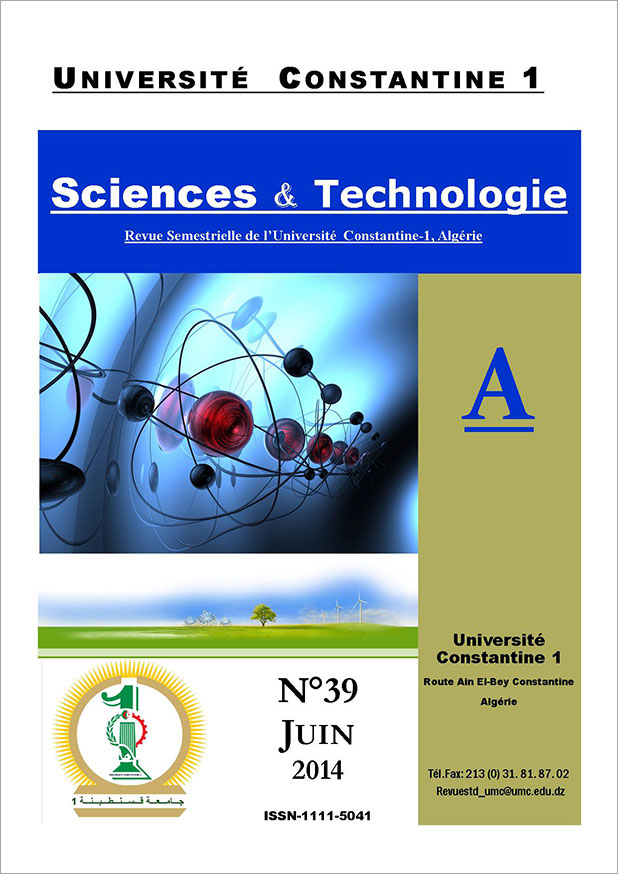COMPARATIVE STUDY OF DEGRADATION OF ISOPROTURON (3-(4-isopropylphenyl)-1,1dimethylurea) PHOTOINDUCED BY FE(III) AND FE(III)-PHOTOINDUCED SONOCHEMICAL IN AQUEOUS SOLUTION
Keywords:
Isoproturon, Photolysis, Photoinduction, SonochemistryAbstract
The degradation of isoproturon 3-(4-isopropylphenyl)-1,1dimethylurea photoinduced by Fe(III) in aqueous solution has been investigated. The rate of degradation depends on the concentration of Fe(OH)2+, the most photoreactive species in terms of .OH radical formation. These .OH radicals are able to degrade isoproturon until total mineralisation. The formation of Fe(II) in the irradiated solution was monitored. The sonophotochemical degradation of isoproturon has been found to be dependent on the intensity of sonication. The combination of ultrasound and photochemistry has been used to degrade an aqueous solution of Isoproturon (IP). The degradation of IP in aqueous solution was investigated under sonolysis at 500 kHz and in the presence of Fe(III), as well as under simultaneous sonolysis and photoinduced Fe(III). Coupling photolysis with ultrasound for degradation of IP has been developed. The photosonochemical decomposition rate constant is greater than the additive rate constants of the two processes. Degradation products were analysed by CG/MS performed in the electron-impact (EI) mode, at 70 eV potential using full scan mode. Degradation photoproducts were identified and a mechanism of degradation is proposed for two processes.
Downloads
References
D.C. Gooddy, P.J. Chilton and I. Harrison, “A field study to assess degradation and transport of diuron and its metabolites in a calcareous soil”, Sci. Total Environ., vol. 297, pp. 67-83, 2002.
M. Lapertot, S. Ebrahimi, S. Dazio, A. Rubinelli and C. Pulgarin, “Photo-Fenton and biological integrated process for degradation of a mixture of pesticides”, Journal of Photochem. and Photobiol. A, vol. 186, pp. 34-40, 2007.
F. Javier Benitez, J. Francisco Real, L. Juan Acero and C. Garcia, “Photochemical oxidation processes for the elimination of phenyl-urea herbicides in water”, Journal of Hazardous Materials, vol. 138, pp. 278-287, 2006.
G.Kulsherstha and S. K. Mukerjee, “The photochemical decomposition of theherbicide isoproturon”, Pest. Sci., vol. 17 , pp. 489-494, 1986.
B. Toepfer, A. Gora and G. Li Puma, “Photocatalytic oxidation of multicomponent solutions of herbicides: Reaction kinetics analysis with explicit photon absorption effects”, Appl. Catal. B: Environ., vol. 68, pp. 171-180, 2006.
A. Gora, B. Toepfer, V. Puddu, G. L. Puma, “Photocatalytic oxidation of herbicides in single-component and multicomponent systems: reaction kinetics analysis”, Appl. Catal. B:Environ., vol. 65, pp. 1-10, 2006.
N. Brand, G. Mailhot, M. Bolte, “Degradation photoinduced by iron (III): method of alkylphenol ethoxylates (APE’s) removal in water”, Environ. Sci. Technol., vol 32, pp. 2715, 1998.
H. Meštánkováa, J. Krýsaa, J. Jirkovský, G. Mailhot, M. Bolte “The influence of Fe(III) speciation on supported TiO2 efficiency: example of monuron photocatalytic degradation”, Appl. Catal. B: Environ., vol. 58, p p. 185-191, 2005.
H. Měštànkovà, G. Mailhot, J. Pilichowski, J. Krýsa, J. Jirkovský, M. Bolte, “Mineralisation of Monuron photoinduced by Fe(III) in aqueous solution”, Chemosphere, vol. 57, pp. 1307-1315, 2004.
C. Catastini, M. Sarakha, G. Mailhot, M. Bolte, “Iron (III) aquacomplexes as effective photocatalysts for the degradation of pesticides in homogeneous aqueous solutions”, The Science of the Total Environment, vol. 298, pp. 219-228, 2002.
T.J. Mason, “Practical Sonochemistry:User’s Guide to Applications in Chemistry and Chemical Engineering, Ellis Horwood”, Chichester, 1991.
K.S. Suslick, “The Year book of Science and the Future, Encyclopedia Britannica”, Chicago, 1994.
L.H. Thompson, L.K. Doraiswamy, “Sonochemistry: science and engineering”, Ind. Eng. Chem. Res., vol. 38, pp. 1215-1249, 1999.
Y.G. Adewuyi, Adewuyi, Y.G., “Sonochemistry: environmental science and engineering applications”, Ind. Eng. Chem. Res., vol. 40, pp. 4681-4715, 2001.
M.K. Hoffmann, I. Hua, R. Hochemer, “Application of ultrasonic irradiation for the degradation of chemical contaminants in water”, Ultrason. Sonochem., vol. 3, pp. 163-172, 1996.
Y.G. Adewuyi, “Sonochemistry in environmental remediation. 1. Combinative and hybrid sonophotochemical oxidation processes for the treatment of pollutants in water”, Environ. Sci. Technol., vol. 39, pp. 3409-3420, 2005.
T.J. Mason, J.P. Lorimer, D.M. Bates, “Quantifying sonochemistry: casting some light on a ‘black art’”, Ultrasonics, vol. 30, pp. 40-42, 1992.
K.C. Teo, Y. Xu, C. Yang, Sonochemical degradation for toxic halogenated organic compounds, Ultrason. Sonochem., vol. 8, pp. 241–2462001.
C. Kormann, D. W. Bahemann, M. R. Hoffmann, “Photocatalytic production of hydrogen peroxides and organic peroxides in aqueous suspensions of titanium dioxide, zinc oxide, and desert sand”, Environ. Sci. Technol., vol. 22, pp. 798-806, 1998.
M. Ashokkumar, T. Niblett, L. Tantiongco, F. Grieser, “Sonochemical degradation of sodium dodecylbenzene sulfonate in aqueous solutions”, Aust. J. Chem., vol. 56 (10), pp. 1045-1049, 2003.
B. Yim, H. Okuno, Y. Nagata, R. Nishimura, Y. Maeda, Sonolysis of surfactants in
aqueous solutions: an accumulation of solute in the interfacial region of the cavitation bubbles, Ultrason. Sonochem., vol. 9 (4), pp. 209-213, 2002.
A.G. Chakinala, P.R. Gogate, A.E. Burgess, D.H. Bremner, “Intensification of hydroxyl radical production in sonochemical reactors”, Ultrason. Sonochem., vol. 14, pp. 509-514, 2007.
K. Jyoti, “Hybrid cavitation methods for water disinfection: simulation use of chemicals with cavitation”, Ultrason. Sonochem., vol. 10, pp. 255-264, 2003.
A. Gáplovský, M. Gáplovský, T. Kimura, Š. Toma, J. Donovalova, T. Vencel, “Method for comparing the efficiency of ultrasound irradiation independent of the shape and the volume of the reaction vessel in sonochemical experiments”, Ultrason. Sonochem., vol. 14, pp. 695-698, 2007.
Y. Suzuki, W.H. Arakawa, A. Maezawa, S. Uchida, “Ultrasonic enhancement of photo-catalytic oxidation of surfactant”, Int. J. Photoenergy, vol. 1, pp. 1-4, 1999.
H. Zhang, H. Fu, D. Zhang, “Degradation of C.I. Acid Orange 7 by ultrasound enhanced heterogeneous Fenton-like process”, J. of Hazardous Materials, vol. 172, pp. 654-660, 2009.
G. Tauber, H. Mark, P.Schuchmann, C. von Sonntag, “Sonolysis of tert-butyl alcohol in aqueous solution”, J. Chem. Soc., Perkin Trans, vol. 2, pp. 1129-1135, 1999.
I. Z. Shirgaonkar, A. B. Pandit; “Sonophotochemical destruction of aqueous solution of 2,4,6-trichlorophenol”, Ultrasonics Sonochemistry, vol. 5, pp. 53-61, 1998.
H. Katsumata, T. Okada, S. Kaneco, T. Suzuki, K. Ohta, “Degradation of fenitrothion by ultrasound/ferrioxalate/UV system ; Ultrasonics Sonochemistry”, vol. 17, pp. 200-206, 2010.
M. Muruganandham, J.S. Yang, J.J. Wu, “Effect of ultrasonic irradiation on the
catalytic activity and stability of goethite catalyst in the presence of H2O2 at acidic medium”, Ind. Eng. Chem. Res., vol. 46, pp. 691-698, 2007.







